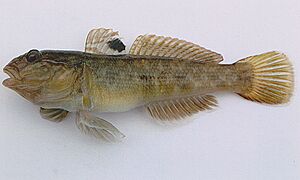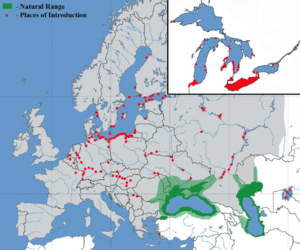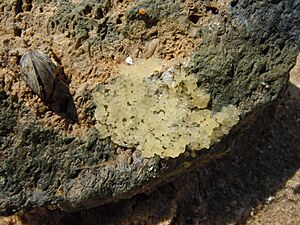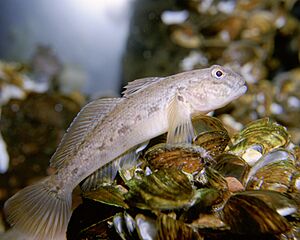Round goby facts for kids
Quick facts for kids Round goby |
|
|---|---|
 |
|
| Conservation status | |
| Scientific classification | |
 |
|
| Range of the round goby and introduction sites | |
| Synonyms | |
|
The round goby (Neogobius melanostomus) is a small fish that lives at the bottom of lakes and rivers. It can survive in both fresh and salty water. This fish is originally from Central Eurasia, like the Black Sea and the Caspian Sea. But now, you can also find many round gobies in new places, such as the Baltic Sea and the Great Lakes in North America.
Contents
What Makes Round Gobies Special?
Round gobies are small fish with soft bodies. They have a clear black spot on their first top fin. Their eyes are big and stick out a little from the top of their head. Like most gobies, their bottom fins are joined together. This forms a disc that looks like a suction cup on their belly.
These fish usually grow to be about 4 to 10 inches (10 to 25 cm) long. The biggest ones can be about 9.7 inches (24.6 cm). They weigh between 0.176 and 2.816 ounces (5 and 80 grams). Older fish are usually heavier. Male round gobies are typically larger than females.
Young round gobies are grey. As they get older, they become spotted with grey, black, brown, and olive green. During the time they lay eggs, adult male gobies turn very dark, almost black. Their cheeks also swell up. You can tell males and females apart by a small part of their body called the urogenital papilla. In males, it is white or grey and pointed. In females, it is brown, short, and blunt.
Where Do Round Gobies Live?
Round gobies are common in the Sea of Marmara and its rivers. They also live in the Black Sea and the Sea of Azov. You can find them along all the coasts and in the freshwaters of these areas. They also live in coastal lakes and lagoons.
They are also found in rivers in Crimea and the Caucasus region. These rivers include the Mezib, Pshada, Vulan, Kodori, and Çoruh. They also live in the Caspian Sea.
How Round Gobies Spread
Since 1990, the round goby has become an invasive species in North America and parts of Europe. This means they are not native to these areas and can cause problems. The first round goby in North America was found in the St. Clair River in 1990.
They are now quickly spreading into rivers that flow into the Great Lakes. They were recently found in Cayuga Lake, one of the Finger Lakes in New York. In 2021, the first round goby was found in the Hudson River.
Round gobies can live in both fresh and salty water. They are often found on shallow parts of the ocean floor. They prefer sandy and rocky bottoms with little mud. They live in water depths from about 3 to 56 feet (1 to 17 meters).
What Do Round Gobies Eat?
Round gobies eat both during the day and at night. They seem to find their food only when they are still. Their main diet includes:
- Mollusks (like snails and clams)
- Crustaceans (like crabs)
- Worms
- Fish eggs
- Zebra mussels (another invasive species)
- Small fish
- Insect larvae
- Other small creatures that live on the bottom of lakes and streams.
In the spring, in places like the Sasyk Lagoon, they mostly eat Hydrobia, Cerastoderma, and Abra. Near the Romanian coasts of the Black Sea, they eat polychaetes (a type of worm), crustaceans, and young gobies. Near Sevastopol, they eat molluscs like Mytilaster lineatus and Abra.
In the Gulf of Odessa, their diet includes many different things. Mytilus galloprovincialis, Setia pulcherrima, Mytilaster lineatus, Lentidium mediterraneum, Idotea balthica, and Alitta (Nereis) succinea are common in spring. In summer, they mostly eat Sphaeroma pulchellum and L. mediterraneum. Mussels like M. galloprovincialis and M. lineatus are important food for them all year.
Round Goby Reproduction

Female round gobies can start having babies when they are one to two years old. Males mature a bit later, at three to four years old. However, gobies in the Laurentian Great Lakes mature faster than those in their native homes in Europe. Females can lay eggs up to six times during the spawning season. This season usually lasts from April to September.
When it's time to mate, males move from deeper water to shallower areas. They release a special scent that attracts females to their spot. Males also do visual displays, like changing their color from beige to black. They can also make sounds to attract females. Females lay their eggs in small spaces between rocks. The males then guard these eggs.
Each egg is about 4 by 2.2 mm in size. A group of eggs can have up to five thousand eggs! Male gobies are very protective. They defend the eggs from other fish that might try to eat them. They also fan the eggs with their fins. This keeps fresh, oxygen-rich water flowing over the eggs. Because of this care, up to 95% of the eggs successfully hatch.
Round Gobies as an Invasive Species

Round gobies were brought to the North American Great Lakes by accident. They likely traveled in the ballast water of cargo ships. Ballast water is water that ships take in to stay stable. Since they were first found in the St. Clair River in 1990, round gobies have become an invasive species. This means they are not native to the area and can cause big changes to the environment and economy.
The effects of round gobies are mixed. They compete with native fish for food and places to live. But they also become food for other native fish. They even eat other invasive species!
Impact on Native Species
Round gobies are aggressive fish. They compete with native fish like sculpin and logperch for food, such as snails and mussels. They also compete for shelter and nesting spots. This can cause the numbers of native fish to go down. Round gobies also eat the eggs of native fish. Many of these native fish are important for fishing. Round gobies are very tough and can live in polluted water. This gives them an advantage over native species.
Unexpected Benefits
Many native fish now eat round gobies. These include smallmouth bass, largemouth bass, walleye, salmon, and trout. Round gobies also eat a lot of invasive mussels, like zebra and quagga mussels. These mussels filter water and can collect harmful chemicals like PCBs. When bigger fish eat gobies that have eaten these mussels, the chemicals can move up the food chain.
However, gobies eating mussels can also be helpful. While they don't get rid of all the mussels, they do help control their numbers. This stops the mussels, which are also invasive, from spreading too much.
Another surprising benefit is for the Lake Erie watersnake. This snake was once a threatened species. But now, round gobies are a tasty new food source for them. A study found that gobies make up to 90% of the snake's diet! This new food supply is helping the water snake population grow again. Round gobies are also food for other fish in the Great Lakes, such as bass, lake trout, lake whitefish, burbot, lake sturgeon, and walleye.
Spread in Europe
Round gobies are also considered invasive in parts of Europe. They first appeared in the Gulf of Gdańsk in the southern Baltic Sea in 1990. They have since spread to the Aegean Sea, other parts of the Baltic Sea, the North Sea basin, and the Danube and Rhine river basins. In the German part of the Baltic Sea, they were first seen near Rügen Island. Now, they are found all along the southwestern Baltic Sea coast. This includes the Stettiner Haff, the mouth of the Warnow river, the Trave river, and the Nord-Ostsee (Kiel) Canal.
By 2010, the westernmost place round gobies were found in Europe was the lower Scheldt river in Belgium. In 2011, round gobies started to invade freshwaters in France. They appeared in the Rhine River (on the border between France and Germany) and in the French part of the Moselle River.
Round Goby Parasites
Round gobies can carry many different types of parasites. In their native areas, over fifty different parasite species have been found in them. Some common parasites in the Black Sea round goby are tiny worms called trematodes. These include Cryptocotyle concavum, C. lingua, and Pygidiopsis genata. Some of these trematodes, like C. lingua and P. genata, can even infect humans. In the 1950s, round gobies were found to carry worms that were deadly to ducklings.
In the Gulf of Gdańsk in the Baltic Sea, the invasive round gobies have twelve parasite species. The main ones are two types of trematode worms: C. concavum and Diplostomum spathaceum. In the Baltic Sea, round gobies also carry another invasive worm called Anguillicoloides crassus. In the Vistula Lagoon, the most common parasites are worms called Hysterothylacium aduncum and Anguillicoloides crassus.
In the American Great Lakes, twenty-five parasite species have been found in round gobies. The trematode D. spathaceum is the most common. Other common parasites include a tapeworm called Proteocephalus sp. and another trematode called Neochasmus umbellus. It seems that the invasive gobies in the Great Lakes have fewer parasites compared to their native homes. This might be because they left their natural enemies behind when they moved to a new place.


